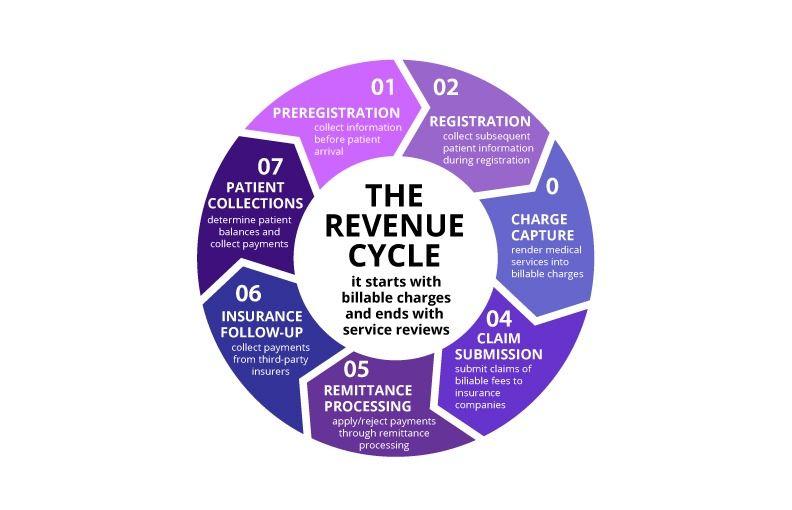According to DeVry University, the revenue cycle is “the process of tracking and analyzing revenue received from patients during the course of their care process.” The cycle revolves around 7 steps, starting from the booking of appointments and concluding when the final costs of a patient’s care are eventually paid. In this article, I will describe the 7 steps of the revenue cycle and its overall functions.
The 7 Steps of the Revenue Cycle
Step 1: Preregistration
Preregistration is the most important step in the Revenue Cycle, as it solidifies the finances of the patient while preventing any questions about payment. Patients, either in-person or through the phone, provide information regarding their demographic, insurance, and clearing house eligibility. These pieces of information go to the patient’s healthcare insurance, which provides the patient’s coverage, co-payment, co-insurance, deductible, and potential referral. Usually, during this process, the medical providers can examine the patient’s financial expectations and potential costs, as well as other factors including payment time and potential policies regarding cancellation, postponement, or the case of not showing up. Finally, these steps culminate in the patient scheduling an appointment.
Step 2: Registration
After the pre-registration is completed, the registration process starts off by ensuring the validity of the patient’s phone number, address, birth date, guarantors, and information regarding their insurance is correct. These pieces of data are normally collected after each time a patient is treated. After the patient provides and validates the necessary information, the providers have to ensure that they have received all of the proper information, which is then used to make co-payments. However, if a potential specialist is needed, then a referral or authorization is needed to treat the patient.
Step 3: Charge Capture
When the process of registration is done, charge capture is initiated, which can be done in 2 ways. The first way it can be done is through automation, in which information is automatically input into the medical providers’ billing system, which can also be based on the documentation they put in. However, some companies prefer to complete the charge capture process in a more out-of-date manner, using staff at the front billing desk to manually input information.
Step 4: Claim Submission and Medical Coding
After getting the charges, the medical provider’s revenue cycle staff will look at the charges, along with other medical codes, most notably the CPT and the Diagnosis code, which will question whether the medical procedure will correspond with the diagnosis. When there is more than one code provided, they must be separated in order to be coded correctly. After this has been completed, a process known as claim scrubbing will be initiated in order to ensure the accuracy of the code and whether they are going to the insurance provider correctly. The more efficient the process is, the quicker the insurance carrier payment will be. In general, the process revolves around sending claims from the medical management into mailrooms, known as clearing houses, which would then be sent to different payers. This leads to the creation of 2 reports: the transmission report, which identifies the claim sent and dropped, and the rejection report, which finds inaccurate medical codes.
Step 5: Remittance
After a medical practice’s claim has been sent, the process of remittance begins, which displays the benefits and service payments. Furthermore, allowables are agreed to during this time, which are the prices that were agreed upon by the provider and the patient. Adding on, fee schedules are also implemented, which represent the amount a provider charges per service. The final part of the remittance process is write-offs, both contractual and non-contractual. Contractual write-offs are inevitable, as they show the rates contracted by the patient and provider, whereas it is possible to avoid non-contractual write-offs, which normally occur when the provider’s revenue cycle system undergoes a stage of inaccuracies.
Step 6: Insurance Payment and Follow-Ups
During this time, medical providers look at the payments that have and have not been made. In order to do this, account receivable, or A/R, reports or creates to highlight the amounts of money that have been paid off by the insurance and/or patient and how much is remaining. This process will justify the validity of the insurance follow-up process and whether there are not any inaccuracies going through it.
Step 7: Patient Payments and Collections
The final step of the revenue cycle is often considered the most difficult, due to the discussion on why to collect money from a patient. Normally, medical companies often use their front desk to collect money from patients during their service times. This process is facilitated through certain company policies, such as ones regarding co-payments and deductible payments.


Leave a Reply